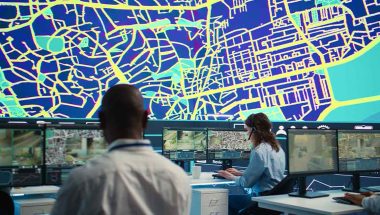- | 9:00 am
Here’s how AI is driving road safety in the Middle East
Several companies in the region are developing AI-driven tech to make roads safer

In August, Dubai made a significant stride in its road safety push by introducing AI-powered pedestrian crossings that incorporate interactive warning systems in accident-prone areas. Last week, Dubai Police unveiled a new mechanism for managing minor traffic accidents by leveraging AI technologies. The new mechanism analyzes minor accidents and instantly issues reports to drivers without human intervention.
However, Dubai is not alone in this endeavor. In May, Abu Dhabi Police launched a road alert system that warns drivers of bad weather and traffic accidents.
Qatar and Saudi Arabia have also embarked on initiatives that harness advanced technology to make their roads safer for all travelers.
INNOVATIONS IN ROAD SAFETY
Dubai Silicon Oasis (DSO), a special economic zone for knowledge and innovation, partnered with Derq, a leading developer of AI-driven traffic technology, to implement 14 AI Smart Pedestrian Crossing Systems across Dubai Silicon Oasis.
Dr. Georges Aoude, CEO and Co-Founder of Derq, emphasized the pivotal role of the Dubai Integrated Economic Zones Authority (DIEZ) in making this project a reality. “DIEZ has played a crucial role in successfully implementing the AI Smart Pedestrian Crossing system in DSO,” he says.
Dr. Aoude shares that these pedestrian crossing systems have AI algorithms to detect and track vehicles and pedestrians approaching the crosswalk. “This technology provides crucial reaction time for drivers, enabling them to slow down and ensure the safety of those crossing the road,” he remarks. Furthermore, the system offers flexibility in “activating and customizing alerts, ensuring optimal safety and efficient traffic management at pedestrian crossings.”
Dubai has also welcomed an AI-powered simulation device to enhance driver behavior assessment. This innovation, introduced by Dubai-based telematics technology firm Location Solutions in collaboration with Slovenian company AV Living Lab and Excellence Driving Centre, marks a significant step toward positioning the UAE as the world’s premier AI-mobility capital.
At the heart of this development is an AI Driving Hub that utilizes custom-designed simulators to evaluate the driving behavior of both new and experienced drivers. The process involves assessing a driver’s skills and behavior by collecting data from a simulator that mimics the driving experience, similar to a video game console. Daniel Avdagic, CEO of AV Living Lab, says,” Drivers can undergo a brief 15-minute simulation, navigating through countryside, highways, and city terrains to evaluate their driving proficiency.”
DRIVING THE FUTURE
Another player in the mobility space is Israel’s Ride Vision, which has introduced a safety system for motorcycles that uses front and rear wide-angle cameras to monitor a motorcycle’s surroundings and provides real-time alerts to the rider through blinking lights on the bike’s side mirrors
As the World Health Organization reported, motorcycles, mopeds, and e-bikes collectively account for nearly 30% of road crash deaths each year. Ride Vision’s alerts are designed to be easily understood, with orange lights indicating no change in trajectory, steady red lights signaling the need for distance, and blinking red lights warning of a potential frontal collision.
Moreover, Ride Vision’s system understands the riders’ psychology and behavior while on the road. For instance, it provides a “dangerous overtake” alert to address the blind spots that motorcyclists often face.
Ride Vision works with motorcycle manufacturers to embed its safety solutions during production. “The entire system works on the psychology of riders, and understanding what will be helpful to the rider to understand the environment, and based on that build the right path or trajectory to move forward,” Ride Vision CEO Uri Lavi says.
LOOKING AHEAD
Qatar has been investing in advanced traffic management systems and intelligent transportation solutions. One notable initiative is the implementation of smart traffic lights equipped with sensors and AI algorithms. These intelligent traffic lights can adapt in real time to traffic flow, reducing congestion and the likelihood of accidents. Additionally, they are designed to prioritize emergency vehicles, ensuring faster response times during critical situations.
Qatar is also exploring the integration of connected vehicle technology. This involves vehicles communicating with each other and traffic infrastructure to improve safety. For instance, connected vehicles can receive warnings about potential hazards ahead, allowing drivers to react promptly and avoid accidents.
“The future is electronic, shared, connected, autonomous, and driven by data,” says Daniel Avdagic, CEO of AV Living Lab. Avdagic notes that to read data, AI is crucial as it will help an autonomous vehicle read the road, comprehend the radar, understand the computer vision, and make decisions, “as well as be used for route optimization – going from A to B.”
Saudi Arabia has taken a significant step forward in road safety by nurturing startups like Hazen.ai that aim to reduce accidents. Hazen.ai’s technology detects and analyzes traffic violations in real-time. Through the use of AI algorithms and cameras, it can identify instances of speeding, reckless driving, and other dangerous behaviors on the road. Doing so not only acts as a deterrent but also helps authorities enforce traffic regulations more effectively.
Moreover, Hazen.ai’s solutions can provide valuable insights into road conditions and traffic patterns, aiding in optimizing traffic management strategies. This enhances safety and contributes to smoother traffic flow, reducing the risk of accidents caused by congestion.
According to WHO, Road traffic crashes claim approximately 1.3 million people’s lives annually. Avdagic notes that AI can “enhance driver assessment, create driver profiles based on driving skills, improve crash data collection and analysis, and more.
Lavi highlights a common behavior among motorcyclists, who tend to rely on turning their heads to scan their surroundings rather than using mirrors when contemplating a lane change. Unfortunately, this practice creates a significant blind spot for riders, especially when another motorcycle or vehicle is approaching rapidly for an overtaking maneuver.
“If our system alerts the rider that they are about to be overtaken by another vehicle, they’ll know that they shouldn’t waste their time moving their head and can focus on what lies ahead,” Lavi explains.
As we move forward, it’s clear that the Middle East is at the forefront of leveraging AI to enhance road safety. From AI-powered pedestrian crossings to innovative motorcycle safety systems, these advancements drive us toward a future with fewer accidents and safer roads, aligning with the region’s ambitious vision for a zero-accident society by 2030.
On some of the technologies to look out for in 2023 that will focus on road safety, Avdagic says that AI-driven metaverse can train drivers, reducing accidents, improving driving behavior, and enhancing road safety. “Another revolutionary safety system using cameras to scan a motorcycle’s surroundings and alert drivers in real-time,” he says.








































